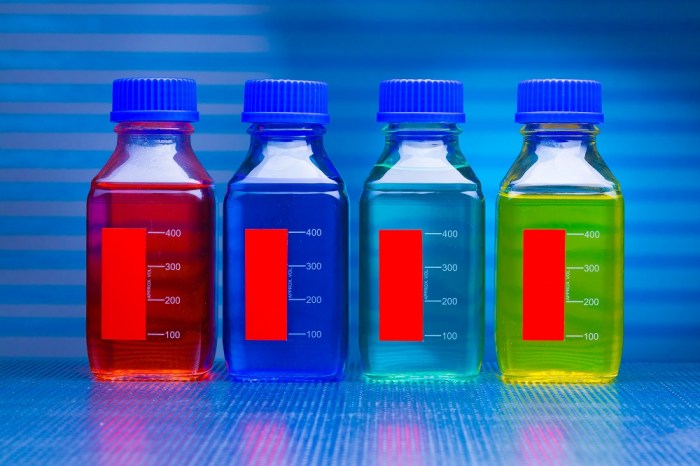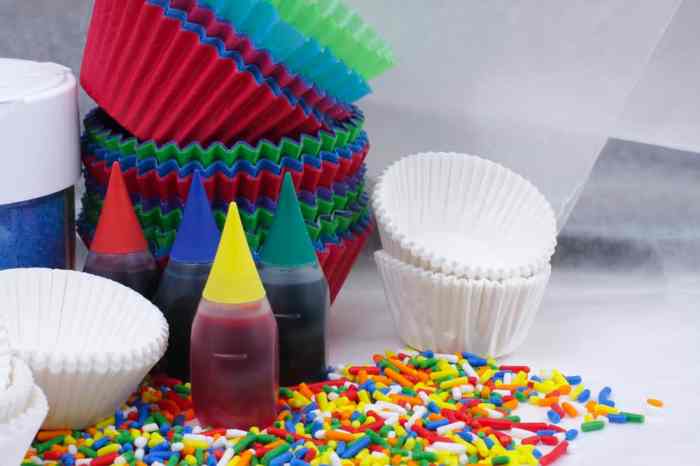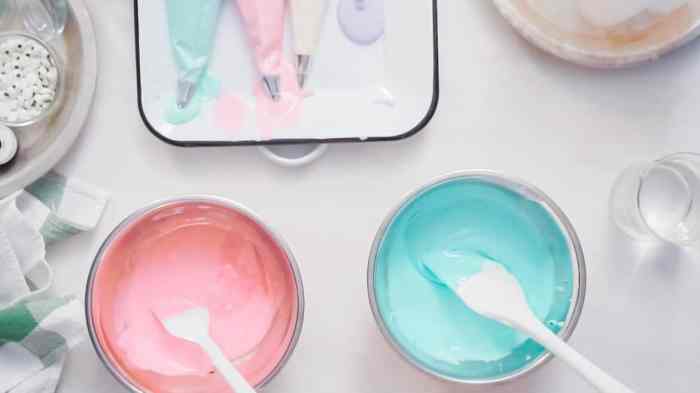Signs of Spoiled Food Coloring

Food coloring go bad – Food coloring, while generally stable, can degrade over time, especially if improperly stored. Recognizing the signs of spoilage is crucial to ensure the safety and quality of your food. Several visual, olfactory, and even textural changes can indicate that your food coloring is no longer suitable for use.
Identifying spoiled food coloring involves observing several key changes. These changes can manifest individually or in combination, providing a clearer picture of the product’s condition.
Visual Changes in Spoiled Food Coloring, Food coloring go bad
Spoiled food coloring often exhibits noticeable visual alterations. These can include a change in the expected color, the appearance of sediment or precipitation, or alterations in its texture. For instance, a vibrant red food coloring might fade to a duller, brownish hue. Similarly, a once-clear liquid might become cloudy or develop a sediment at the bottom of the container.
Observe the fleeting nature of vibrant hues, even in the seemingly simple world of food coloring; their brilliance fades, a subtle reminder of impermanence. To craft a delicate pink, however, requires understanding the precise balance of color, as detailed in this guide on what colors make pink using food coloring. Just as those carefully mixed shades eventually lose their vibrancy, so too do all things eventually transform; a profound lesson in the ephemeral beauty of existence.
This precipitation is often indicative of chemical breakdown. The texture might also change; a liquid food coloring may become thicker or develop a grainy consistency.
Odor Changes in Spoiled Food Coloring
While many food colorings are odorless, some might develop an off-putting smell as they spoil. This could manifest as a musty, sour, or otherwise unpleasant odor, significantly different from its original scent (or lack thereof). A rancid or chemical-like smell is a strong indication that the food coloring has degraded and should be discarded.
Impact of Spoiled Food Coloring on Food
Using spoiled food coloring can negatively affect the taste and texture of your food. The off-flavors introduced by degraded coloring agents can range from subtle bitterness to strong, unpleasant tastes. The altered texture of the spoiled food coloring might also result in a grainy or lumpy consistency in your final product. For example, using a spoiled red food coloring in a cake might result in a slightly bitter taste and a less smooth texture.
Safety Risks of Using Expired Food Coloring
While the direct health risks associated with using slightly expired food coloring are generally considered low, it’s crucial to avoid using significantly degraded products. The breakdown of the coloring agents can lead to the formation of potentially harmful byproducts. Additionally, the presence of mold or bacteria in a compromised container is a significant health concern. It’s always best to err on the side of caution and discard any food coloring that exhibits signs of spoilage.
Proper Storage Techniques for Food Coloring

Proper storage is crucial for maintaining the vibrancy and longevity of your food coloring. Improper storage can lead to color fading, thickening, and even bacterial growth, rendering your food coloring unusable. This guide Artikels the best practices for storing different types of food coloring to ensure they remain fresh and effective for as long as possible.
The type of food coloring and the storage method significantly impact its shelf life. Liquid food colorings, for example, are more susceptible to contamination than powdered versions. Understanding these differences allows for targeted storage strategies to maximize the usable life of your supplies.
Storage Recommendations for Different Food Coloring Types
Different types of food coloring require slightly different storage approaches to optimize their shelf life. The following recommendations consider the unique characteristics of each type.
- Liquid Food Coloring: Store liquid food coloring in tightly sealed, preferably glass, containers in a cool, dark, and dry place. Avoid extreme temperatures, as heat can degrade the color and potentially cause bacterial growth. Refrigeration is generally recommended for extending shelf life.
- Powdered Food Coloring: Powdered food coloring is generally more stable than liquid varieties. Store in airtight containers in a cool, dark, and dry place. A cool, dark pantry or cupboard is suitable. Refrigeration isn’t strictly necessary but can help to extend its shelf life.
- Gel Food Coloring: Gel food colorings, due to their thicker consistency, should be stored similarly to liquid food colorings. Airtight glass containers in a cool, dark place, ideally refrigerated, are recommended.
Best Practices for Maintaining Food Coloring Quality
Following these best practices will help maintain the quality and extend the shelf life of your food coloring, regardless of type.
- Airtight Containers: Always use airtight containers to prevent moisture from entering and potentially causing clumping (in powders) or spoiling (in liquids and gels). This helps maintain the color’s consistency and prevents oxidation.
- Cool, Dark Place: Avoid storing food coloring in direct sunlight or in areas with fluctuating temperatures. Heat and light can degrade the color pigments and reduce the shelf life. A cool, dark pantry or cupboard is ideal; refrigeration is best for liquids and gels.
- Proper Labeling and Dating: Label containers with the date of purchase or opening. This helps you track the age of your food coloring and ensure you use the oldest ones first. Discard any food coloring that shows signs of spoilage (thickening, discoloration, unusual odor).
- Clean Utensils: Always use clean, dry utensils when accessing your food coloring to avoid introducing contaminants.
Comparison of Storage Containers: Glass vs. Plastic
Both glass and plastic containers can be used for storing food coloring, but each has advantages and disadvantages.
- Glass Containers: Glass is generally preferred for its inertness. It doesn’t react with the food coloring, preventing any potential chemical changes that might affect color or quality. Glass is also more resistant to staining and easier to clean thoroughly.
- Plastic Containers: Plastic containers are lightweight and often less expensive than glass. However, some plastics can leach chemicals into the food coloring over time, especially with prolonged exposure to heat or sunlight. Choose food-grade plastics specifically designed for food storage and avoid using recycled plastics.
Impact of Spoiled Food Coloring on Food Products

Using spoiled food coloring in food products can have several undesirable consequences, impacting the final product’s appearance, taste, and even potentially its safety. The extent of the impact depends on several factors, including the type of food coloring, the degree of spoilage, and the type of food product it’s used in. Generally, however, it’s best to avoid using any food coloring that shows signs of spoilage.Spoiled food coloring may exhibit changes in its chemical composition due to bacterial growth or oxidation.
This can lead to off-flavors, altered textures, and unexpected color changes in the final food product. The severity of these changes varies depending on the food itself and the amount of spoiled coloring used. In some cases, the changes might be subtle, while in others, they could render the food inedible.
Changes in Taste and Odor
Spoiled food coloring can introduce unpleasant tastes and odors to food products. Imagine a batch of vanilla cupcakes where the food coloring has begun to ferment; the subtle vanilla flavor might be overwhelmed by a sour or musty taste, making the cupcakes unappetizing. Similarly, a beverage like lemonade, colored with spoiled red food coloring, could acquire a strange, off-putting taste, significantly affecting its palatability.
The degree of taste alteration depends on factors such as the type and amount of spoiled food coloring and the inherent flavor profile of the food itself. A strongly flavored food might mask the off-taste more effectively than a delicately flavored one.
Changes in Texture and Appearance
Beyond taste, the texture and appearance of food can be affected by using spoiled food coloring. For example, a cake batter colored with spoiled food coloring might exhibit unusual thickening or thinning, leading to an altered texture in the final baked product. The cake might be gummy, crumbly, or otherwise different from its intended consistency. In the case of a frosting, the spoiled coloring might cause separation or curdling, making it difficult to spread or creating an undesirable appearance.
Similarly, the color itself might be unpredictable; instead of a vibrant red, you might end up with a dull, brownish hue, or even an unexpected color altogether due to chemical reactions within the spoiled coloring.
Examples of Spoilage Effects in Different Food Types
Let’s consider some specific examples. Using spoiled green food coloring in a batch of cookies might result in cookies that have a slightly bitter taste and a dull, uneven green color. The texture might also be affected, leading to drier or more brittle cookies. In contrast, using spoiled yellow food coloring in a custard might result in a custard with an off-putting odor and a slightly curdled texture.
The color itself might be less vibrant or even slightly different from the expected shade of yellow. These examples illustrate how the impact of spoiled food coloring can vary significantly depending on the food product and the type of spoilage.
FAQ Summary: Food Coloring Go Bad
Can I freeze food coloring to extend its shelf life?
Yes, freezing can extend the shelf life of some food colorings, particularly liquid varieties. However, ensure you use airtight containers to prevent freezer burn and potential contamination.
What happens if I use expired food coloring?
Using expired food coloring may result in a change in color intensity, an off-taste or odor, or even potential safety concerns depending on the degree of spoilage. It’s best to err on the side of caution and discard expired coloring.
How can I tell if my food coloring is still good without testing it in food?
Check for changes in color (fading, dullness), texture (thickening, separation), and odor (unusual smell). If any of these are present, it’s likely spoiled.
Are natural food colorings less prone to spoilage?
Not necessarily. While some natural colorings may have shorter shelf lives due to the absence of preservatives, others can be quite stable. Check the expiration date and storage instructions on the packaging.
